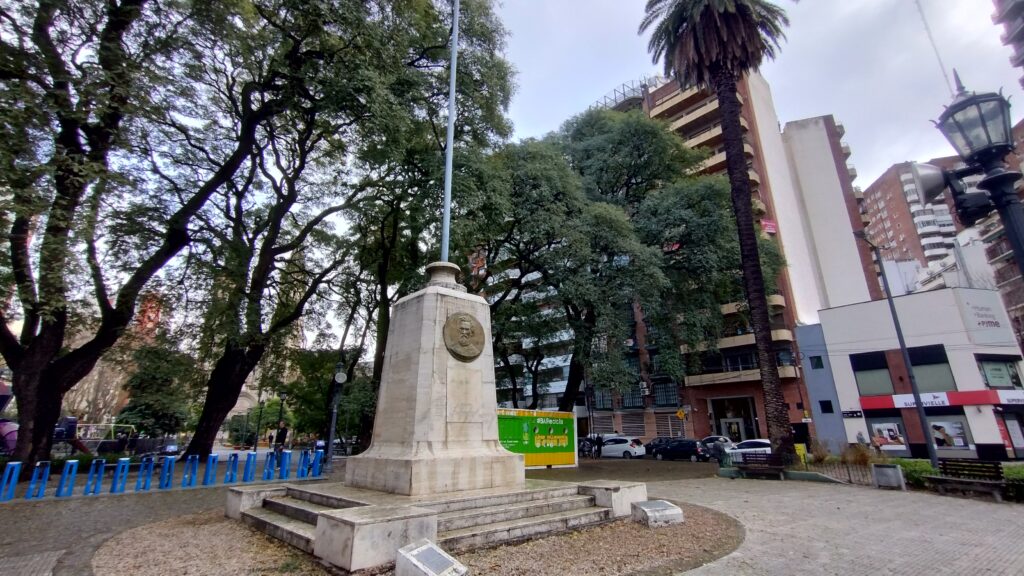Each square in the Palermo neighborhood has its own imprint. Therefore, visiting each one of them is a tourist tour worth doing, especially if you are bored of museums and places where only the past is talked about.
The Plaza Güemes in the Palermo neighborhood is not only a tribute to one of the heroes of the Argentine Republic. It is also an ideal place to walk, relax and learn a little more about this iconic neighborhood of Buenos Aires.
If you do not frequent this area of Palermo and want to discover it once and for all, then get ready, because Plaza Güemes and its surroundings have a lot to offer you as a tourist or foreigner residing in Buenos Aires.
Plaza Güemes (Buenos Aires): Everything You Need to Know Before Your Visit
What is Plaza Güemes?
Plaza Güemes is named after General Martín Miguel de Güemes (1785-1821), a key figure in Argentina’s struggle against British invasions and the May Revolution, who played a vital role in organizing the defense of the nation against royalist counteroffensives in the north. He also served as the chief general in the mission to Peru.
The plaza is also commonly referred to as “Plaza Guadalupe” due to its proximity to the Basílica del Espíritu Santo, which houses the image of the Virgen de Guadalupe.
Historically, the area where the plaza now stands was once a lagoon near the Maldonado stream. In recent years, various renovation projects have modernized the plaza, adapting it to the needs of the local residents. These improvements include flowerbeds, a children’s play area, and a flagpole with a bas-relief honoring Martín Miguel de Güemes.
The neighborhood surrounding the plaza is often informally called “Villa Freud” due to the high concentration of psychological practices in the area.
Plazoleta Monte Ararat
In front of Plaza Güemes is Plazoleta Monte Ararat, a green space dedicated to the Armenian community in Argentina and the victims of the Armenian genocide by the Ottoman Empire in the early 20th century.
This small plaza extends into a charming boulevard along Charcas Street, which eventually connects to a pedestrian area leading to Coronel Díaz Avenue.
Commercial and Educational Area
The area around Plaza Güemes is home to various businesses, including gyms, cafes, and restaurants. You’ll also find banks, large buildings, and several churches, with the Parroquia Nuestra Señora de Guadalupe being the most prominent.
Additionally, there are several traditional schools, mostly offering Catholic education, and a significant number of psychological practices, contributing to the neighborhood’s nickname, “Villa Freud.”

Where is Plaza Güemes?
Plaza Güemes is located in the Palermo neighborhood, south of Scalabrini Ortiz and Santa Fe Avenues. It is one of many green spaces in Palermo, situated near Plaza Inmigrantes de Armenia and Plaza Unidad Latinoamericana.
The plaza is bordered by Charcas, Medrano, Mansilla, and Salguero streets. It also has an “annex” in the form of the iconic Parroquia Nuestra Señora de Guadalupe, which has lent its name to the plaza for many years.
To the south of Plaza Güemes, the Palermo neighborhood extends a few more blocks until reaching Córdoba Avenue, where the Almagro neighborhood begins. To the east, you can reach the Recoleta neighborhood, primarily by following Santa Fe Avenue.
Nearby attractions include Alto Palermo Shopping, one of Buenos Aires’ most important shopping centers, Las Heras Park, the Palermo Rural Exhibition Center, the Ecoparque, and the Botanical Garden. Santa Fe Avenue is also a major commercial street with many top-brand stores.
How to Get to Plaza Güemes?
The easiest way to get to Plaza Güemes is by taking the subway. The D line has a station at Bulnes, located on Santa Fe Avenue, just four blocks from the plaza.
The area around Plaza Güemes is well-served by buses, making them another convenient option for getting there. The following bus lines can take you close to Plaza Güemes: 15, 29, 39, 57, 64, 68, 110, 111, 152, 160, 188.
If you prefer, you can also choose to bike or drive to Plaza Güemes. There are private parking lots nearby, and the area is generally easy to navigate in terms of traffic and congestion on most days.
Why Visit Plaza Güemes?
Enjoy the Plaza and Its Surroundings
One of the highlights of Plaza Güemes is the beautiful view you can enjoy with the Parroquia Guadalupe in the background. This view is especially stunning at night when both the plaza and the church are illuminated against the dark sky.
The plaza also offers various spots to sit and enjoy some fresh air. While it may not be the greenest space in the city, it provides a lovely view of the open sky.
Additionally, the area maintains a balance between activity and relaxation, depending on the day and time.
Visit the Parroquia Nuestra Señora de Guadalupe
The Parroquia Nuestra Señora de Guadalupe is one of the most beautiful churches in Buenos Aires, with its distinctive architectural design featuring two large domes. Its location next to Plaza Güemes makes the basilica even more impressive. The church offers five masses on Sundays and two daily masses from Monday to Saturday.
Whether you’re religious or not, a visit to this stunning church is worthwhile to admire its architecture, stained glass windows, and murals.
Enjoy a Coffee Overlooking the Plaza
The area around Plaza Güemes is dotted with cafes and bars, perfect for taking a break during your visit.
There’s nothing better than enjoying a coffee or a meal with the Parroquia Guadalupe and Plaza Güemes as your scenic backdrop.
Explore the Charcas Boulevard
Beyond Plazoleta Monte Ararat and its monument, you’ll find a boulevard in the middle of Charcas and República Dominicana streets. If you follow this boulevard, it will lead you to a pedestrian area filled with more bars and cafes.
This area is also bustling at night, with breweries and bars mixed in with cafes and quieter spots, making it a lively place to explore after sunset.


